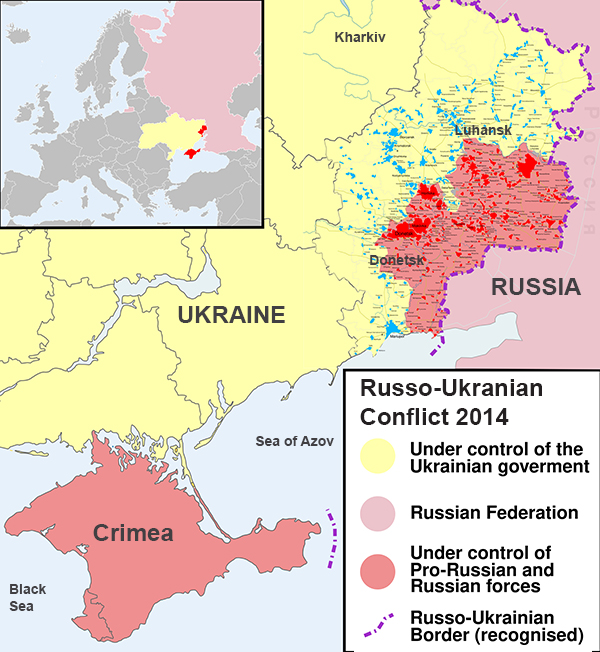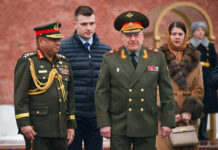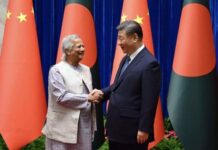Backdrop
The roots of the current military crisis in Ukraine can be traced back to the events surrounding the breakup of the former USSR. The USSR was one of the two superpowers in the bi-polar era. However, it was a wounded giant that had, in fact, not really recovered from the staggering manpower and material losses of World War II. Its economy was highly dependent on export of oil and gas. America engaged it in a geo-economic competition. It started the Star Wars arms race. In the 1980s, the USA made a deliberate effort to bring down the prices of oil globally by engineering an oil glut. Oil prices went into free-fall ($10- 30 a barrel) and severely derailed the Soviet economy. Afghanistan added to the hemorrhaging.
The USSR was an over militarized state. By 1990, it simply collapsed from what Paul Kennedy calls economic overreach and imperial over-stretch. A superpower went down without a shot being fired and the world was shocked. A uni-polar global order, now led by America and the West, came into being. The Soviet Union splintered with many of its republics in Eastern Europe and Central Asia seceding. There was chaos in Russia and it struggled to restore order.
NATO Expansion
The West had initially promised that there would not be even an inch of NATO expansion in Eastern Europe (US Foreign Secretary James Baker’s assurance to Gorbachov). All these verbal assurances, however, were violated with impunity. As a result of Russian military and economic weakness, NATO expanded eastward in four distinct phases:-
Phase One 1990. Poland, Hungary and Czech Republic – three former Warsaw pact countries joined NATO.
Phase Two 2004. Seven countries to include Estonia, Latavia, Lithuania, Slovakia, Rumania, Bulgaria and Slovenia followed suit.
Phase Three 2009. Albania and Croatia joined NATO.
Phase Four 2017-2019. Montenegro and Macedonia followed suit. Thus, by 2019, some 14 countries in Eastern Europe had Joined NATO.
President Vladimir Putin of Russia rapidly started closing the conventional military gap. By 2008, Russia hit back hard in Georgia and then in 2014 it captured Crimea in Ukraine. The present crisis has really been precipitated by the clear change in military-technical capabilities, which have altered the local conventional military power balance in Eastern Europe. Putin is now determined to change the security architecture in Europe to reflect these military realities and has virtually issued demarches to the US and NATO to renegotiate the security equations in Europe. He has mobilized the largest number of troops on the border of Ukraine in a clear coercive deployment, a use of force without war to re-negotiate security terms in Europe. If he can do it without war it would suit him eminently. The danger is that if he does not get the outcomes he seeks, he is fully prepared and ready to go to war.
In a clear escalation, the Russian Duma recommended recognition of Dontesk and Luhansk provinces in Ukraine, where Russian separatists are fighting and, on 21 February, Putin duly announced recognition of these two states. Economic sanctions did not deter him as he feels Russia’s core strategic interests are involved and he has articulated his red lines so publically that there is no chance of him recalling his troops without enforcing his red lines. He would lose great face domestically and internationally and he simply cannot afford that. Putin has acted decisively as he is fully prepared for the next steps in the military escalation ladder.
Military – Technical Factors
It is my contention that these sea-saw in the fortunes of Russia and the West can be traced back to the swings in the conventional military power balance between the two blocks from 1990 to date. These were largely focused on gaining superiority in air power and anti-air defenses. From World War II onwards, air superiority had become a decisive war winning factor. The Korean War saw a stalemate in air power and that shaped the stalemate on the ground. The Vietnam War saw US war planes and helicopters taking huge losses (over 3400 lost) from rudimentary Soviet Air defences and surface-to-air missiles (SAMs). The Americans deeply studied these and learnt major lessons. They began to make a serious bid to regain air superiority. They learnt from Israeli experiences in the 1967 and 1973 Conflicts.
By 1973, low level Russian SAM-6 and SAM-7 missiles had inflicted fearful losses to aircraft flying at the low level to evade radar. Meanwhile, USA had fielded a number of new fourth-generation fighters like F-15, F-16 and F-18 as also the AWACs and AEWs. Then came the precision guided munitions (PGMs) by 1990, which created a significant military technical revolution (Revolution in Military Affairs) with far reaching impact. These enabled aircraft to bomb from mid and high altitude without losing accuracy. Thus, they could stay out of the low firing SAM envelopes. The US demonstrated this in the first war against Iraq, when Soviet-era weapons were decimated and air power paved the way for a decisive victory.
The USSR had imploded as a result of economic decline and these military technical factors added to Russian weakness. Thereafter, it was a uni-polar world with USA as the sole superpower based on its conventional military superiority in air power. Things began to stabilize in Russia only when Putin took charge around the turn of the century. Slowly, the Russians began to close the air power gap with their Su-27, Su-30 and Su-35 jet fighters along with MiG-29s and their own AWACs and PGMs. Thus, by 2008, we once again saw the Russians asserting themselves in Georgia. The Americans had sought to regain superiority by investing heavily in stealth technology and fielded stealth aircraft like F-22, F-35 fighters and B-2 bombers and beyond-visual-range (BVR) missiles for air-to-air combat. The problem was this technology was frightfully expensive and stealth aircraft could not be fielded in large numbers because of cost factor.
Thus, in 2014, we saw Russia again capturing Crimea and seizing parts of Donbas. Today, we are seeing the Impact of the Russian S-400 and S-500 Triumf missile systems upon the Eastern European battlefield. These air defence (AD) missile systems have radars that can look out to 600 kms and pick up stealth aircraft. They have multiple missiles that can engage enemy aircraft from 40 out to 400 kms. They can achieve Anti Access & Area Denial (A2AD) capabilities and totally deny the airspace over the combat area. This, and a whole host of other weapons, which Russia had tested in Syria have today given it the confidence to decisively challenge the USA and NATO enforced status quo in Eastern Europe and seek a radical re-structuring of the security architecture in Europe. This is a decisive inflexion point and the crisis in Ukraine is a direct outgrowth of the shift in military-technical factors in favour of Russia.
The simple fact is that the USA and NATO have ruled out military retaliationand are relying primarily on economic sanctions to deter Russia. The implications are clear – USA is in no position now to take on Russia militarily in its own backyard. This is what has clearly emboldened Russia to exploit the military–technical advantage it has gained in recent years. It has now gone ahead despite threat of economic sanctions and recognized the Russian majority states of Dontesk and Luhansk giving a fait accompli to US and NATO. However, the crisis is far from over.
Russian redlines were not Dontesk and Luhansk but non-inclusion of Ukraine in NATO and no stationing of offensive weapons in the 14 East European nations recently incorporated into NATO. These have not been met and Russia, to my mind, will pursue them doggedly. Are we seeing the multi-polar moment?
Use of Force Without War: Op Parakram Anology
To back his demands Putin had deployed some 1,50,000 Russian troops around Ukraine. To cite an anology – it was like Operation Parakram, India’s massive deployment on Pakistan’s border after the terror attack on its parliament. This is using military deployment for coercion. The aim is to clearly threaten the use of force to achieve tangible results. This is the use of force without war. That is what Russia is doing currently. Will it work? Only if the use of force threat is credible. India lacked a clear military edge over Pakistan then and our political will to wage war was very tenuous. In Russia’s case, they have the military edge locally and their intent to Invade if their demands are not met is deadly serious. The USA and NATO have already thrown in the towel by clearly stating they will put no boots on the ground and restrict themselves to economic sanctions. Russia has now moved troops into Dontesk and Luhansk provinces of Ukraine. Should Ukraine retaliate, Russia will escalate dramatically as its military is fully poised to do so.
Stake Analysis
It is simply a case of stake analysis. Russia has crucial strategic stakes in Ukraine. It is the direct historical invasion route and abuts Russian borders. It has vital mineral reserves like Uranium, Titanium and natural gas, etc. Russia simply cannot afford to let it become part of NATO. It now has the military capability to stop NATO and can wreck Ukraine whenever it wants to. US and NATO can do little more than enforcing economic sanctions. Conversely, America has few strategic stakes in Ukraine except to needle Russia and stop the Nord 2 gas pipeline as part of the famed economic sanctions. Real economics now comes in significantly. The Nord 2 Russian gas will cost Germany $270 per 1000 cubic feet, whereas the American gas will cost them a $1000 per 1000 cubic feet. The US, perhaps, would be happy to see a war in Ukraine, which stops the Nord 2 gas and forces Germany to buy from USA. France and Germany have major economic linkages with Russia and are already very uneasy with the US resolve to push Russia to invade Ukraine for American profit in gas. That is why President Macron of France is making the most energetic efforts to stop the war.
What about Russia? Its stakes in Ukraine are simply crucial. Putin has clearly announced Russian red lines. He cannot backtrack. With Chinese help he can deal with western sanctions which will hurt Germany and France equally. The simple fact is that Putin cannot afford a military pull back with no concrete security outcomes. Initially, he seemed inclined to give negotiations a chance. He had written a letter to Joe Biden, in December 2021, spelling out his demands for security restructuring in Europe. In January, he got a reply that seemed rational to the Russian foreign minister Lavrov. Putin decided to give the negotiators a chance. Immediately, the US hardened its stance and began to boast that they had coerced Russia into backing down and that Ukraine had the right to choose its form of government and alliances. Russia simply stopped the withdrawal and increased the number of troops around Ukraine to some 1,90,000. In fact, out of Russia’s 12 Combined Arms Armies (corps) 11 are now deployed around Ukraine. They have staged forward their tanks, self propelled artillery and S-400 and S-500 missile systems. The Su-35 fighter bombers, attack helicopters and Iskander missiles have been deployed. The Russians were carrying out a major military exercise in Belarus with their 41st Army. This was to end on 20 February but Belarus has announced that Russian troops will stay on till NATO forces are in Poland, etc. The forces in Belarus are directly poised to strike at the Ukranian capital of Kiev and destroy the main command and control node. Stepping on the escalatory ladder the Russian Duma recommended that Russia recognise Dontesk and Luhansk. Putin announced that on 21 February, throwing down the gauntlet. Should Ukraine respond militarily it will be the pretext that Russia needs for a limited or partial invasion of Ukraine.
Simply stated, Putin will try his best to get without war the realignment of the security architecture in Europe by his coercive military deployment. If it works, well and good. The point to note is that if it does not, he is determined to go ahead and use major military force to underline his intent. That military reality force is now fully poised on ground.



















